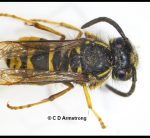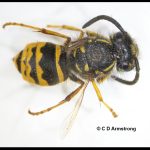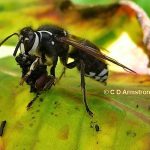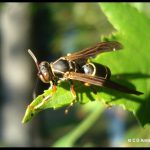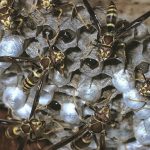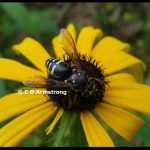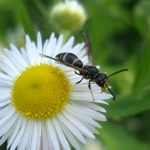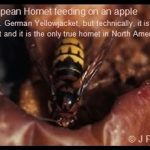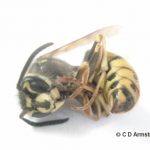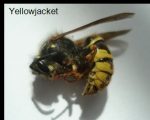Hornets, Wasps and Yellowjackets
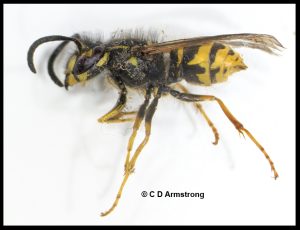
Many of Maine’s hornets, wasps and yellowjackets are members of the Vespidae family of insects. They are social insects capable of repeatedly stinging if they feel threatened or feel their nest is in danger. They can be a significant nuisance throughout Maine, particularly in mid to late summer when colonies reach peak numbers. The colony (nest) is started each spring by a single fertilized queen and continues to grow through the summer as more workers hatch. Hornets, wasps and yellowjackets may be aerial or ground nest builders, producing grayish paper nests in trees, shrubs, and under building eaves. They may also nest in the ground, in logs, or in the walls of structures. They prey on caterpillars and other insects, though yellowjackets will also scavenge and are often attracted to sugary and high-protein foods in garbage containers.
Examples:
- Yellowjackets are small, typically yellow and black wasps, approximately 1/2-3/4 of an inch in length. They tend to be more aggressive than other wasps and will defend their colony vigorously.
- American / Alaska Yellowjackets (generally nest in the ground but not always) (BugGuide.net)
- Bald-faced hornets (these are technically a type of yellowjacket and are not a ‘true’ hornet). They have black and white patterns (no yellow at all) and range from 5/8-3/4 of an inch in length. They, too, are aggressive and may attack with little provocation.
- Common Aerial Yellowjackets (BugGuide.net)
- Eastern Yellowjackets (BugGuide.net)
- German Yellowjackets (BugGuide.net)
- European hornets (University of Kentucky)
- Paper wasps are typically long-legged with spindle-shaped abdomens and tend to be less aggressive than yellowjackets.
- Guinea Paper Wasps (BugGuide.net)
- Potter Wasps
- Catskill Potter Wasp (Ancistrocerus catskill) (BugGuide.net)
- See also:
- Ancistrocerus catskill (Canadian Journal of Arthropod Identification)
- Catskill Potter Wasp (Minnesota Seasons)
- Good Photo of a Catskill Potter Wasp (BugGuide.net; photo taken in New Brunswick, Canada, at Fundy National Park)
- Sand Wasps (Missouri Dept of Conservation)
- See also: Ichneumonid wasps (Texas A&M)
- American Yellowjacket / Alaska Yellowjacket (Vespula alascensis) (female worker) (Searsport, ME; 7/23/2023)
- American Yellowjacket worker with her wings removed in order to see more of the unique abdominal patterning
- Bald-faced Hornet (Dolichovespula maculata) (technically a type of yellowjacket) (shown here holding the remnants of an insect which was probably preyed upon by the hornet)
- Golden Paper Wasp (also known as Northern Paper Wasp)
- Guinea Paper Wasps (Polistes exclamans)
- A sand wasp (Bicyrtes ventralis) (Troy, Maine; 7/29/2009) Sand wasps are solitary, non-aggressive and beneficial.
- Catskill Potter Wasp (Ancistrocerus catskill) (Troy, ME; 6/17/2008) (This wasp is a solitary species of Vespid wasp in the group known as Potter and Mason wasps.)
- European Hornet (select the rightmost photo for a side-by-side comparison with a yellowjacket)
- Common Aerial Yellowjacket
- Yellowjacket and European Hornet – Select the image to see two photos side-by-side for easy comparison
Management:
To reduce the risk of encountering yellowjackets and other stinging wasps, remove waste frequently and maintain tight lids on trash cans. If yellowjackets are present, avoid using perfumes and wearing bright colors, and keep food and drinks covered. Commercial traps can be effective for yellowjackets but are typically not attractive to bald-faced hornets or to paper wasps. Hornet, wasp and yellowjacket nests should not be disturbed unless they pose a risk. Nuisance nests are most easily removed in early spring before the colony has had a chance to grow. Larger, well-established nests may pose enough of a risk to warrant treatment. Nests should be treated at night when the wasps are least active. Insecticide treatments should be sprayed directly into the nest entrance, whether it is above or below ground. If the nest is located inside a wall, the entrance should be located and treated but not plugged to ensure that the insecticide is carried into the nest and to avoid insects showing up inside the structure. Stings can be painful and potentially life-threatening to those with allergies. Be sure to wear protective clothing when treating and removing nests.
See also:
- Wasps and their role as a beneficial insect and pollinator (Wasps are beneficial in the environment) (Penn State Master Gardener Program)
- Controlling Wasps, Hornets and Yellowjackets (University of Kentucky) (En español: El control de avispas, avispones y avispas)

